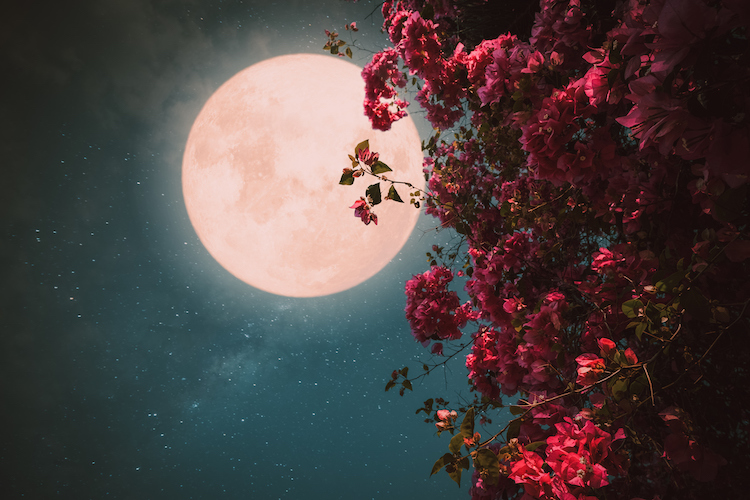- Home
- The Feature
- What is A Pink Moon and When Can You View It?

What is A Pink Moon and When Can You View It?
As the sun sets and darkness falls, the night sky captivates us with its celestial wonders. Among these enchanting phenomena, the Pink Moon stands out as a captivating spectacle that has captured the imagination of people throughout history. And lucky for us there is a ‘pink’ moon on the horizon.
The history and cultural significance of the Pink Moon
The Pink Moon, despite its name, does not actually appear pink in color. The name is derived from the vibrant pink wildflowers, known as “phlox,” that bloom during this time of year in North America. This full moon is also referred to as the “Sprouting Grass Moon,” “Egg Moon,” or “Fish Moon” in different cultures.
In Native American folklore, the Pink Moon symbolizes the arrival of spring, signaling rebirth and renewal. For the Indigenous peoples of North America, this lunar event marked the time for planting crops and preparing for the abundance of the coming season. The Pink Moon held great cultural significance, serving as a reminder of the interconnectedness between nature and human life.
The science behind the Pink Moon
While the Pink Moon carries cultural and historical significance, it is also rooted in scientific explanation. The Pink Moon occurs when the moon is at its fullest phase during the lunar cycle. This phenomenon takes place when the moon is directly opposite the sun, with Earth positioned between the two celestial bodies.
The moon appears to have a pinkish hue during moonrise and moonset due to the scattering of light in the Earth’s atmosphere. This scattering causes shorter wavelength colors, such as blue and green, to disperse while longer wavelength colors, like red and orange, dominate the sky. Although the Pink Moon is not actually pink, the atmospheric conditions create an illusion of a rosy hue, adding to its mystique.
When is the April full moon?
The next full moon is on April 23. This full moon should reach peak illumination around 7:49 p.m. ET/6:49 p.m. CT.
The best places to view the Pink Moon
To witness the Pink Moon in all its glory, it is essential to find a location with minimal light pollution and a clear view of the eastern horizon. Rural areas, away from the bright city lights, offer the best chances of observing the Pink Moon’s stunning rise.
Places such as national parks, secluded beaches, or hilltops provide ideal vantage points for experiencing the Pink Moon’s mesmerizing ascent. Imagine standing on a quiet mountaintop, surrounded by nature’s serenity, as the Pink Moon slowly emerges from the horizon, casting an ethereal glow on the landscape below.
Tips for photographing the Pink Moon
Capturing the beauty of the Pink Moon through photography can be a delightful and rewarding experience. To ensure stunning photographs, consider the following tips:
- Equipment: Use a DSLR camera or a smartphone with manual settings to have more control over the image.
- Tripod: Stability is crucial for capturing detailed shots of the moon. Invest in a sturdy tripod to avoid camera shake.
- Long Lens or Telephoto Lens: To capture the intricate details of the Pink Moon, a long lens or telephoto lens will allow for closer shots.
- Exposure Settings: Experiment with different exposure settings to achieve the desired effect. Start with a low ISO, a higher shutter speed, and adjust accordingly.
- Composition: Incorporate elements of the landscape, such as trees or buildings, to create a captivating composition with the Pink Moon as the focal point.
With these tips in mind, you can immortalize the Pink Moon’s breathtaking splendor in your photographs.
Pink Moon myths and folklore
Throughout history, the Pink Moon has been steeped in myths and folklore, adding to its allure. In some cultures, it was believed that the Pink Moon had the power to bring luck, prosperity, and fertility. Others saw it as a time of heightened spiritual energy, where wishes and intentions were more likely to manifest.
In Norse mythology, the Pink Moon was associated with the goddess Freya, the goddess of love, beauty, and fertility. It was believed that during this time, Freya would bless the earth with her presence, bringing an abundance of love and fertility to the land.
This captivating lunar event reminds us of the intricate connection between humanity and the natural world, inviting us to appreciate the wonders that unfold above us each night.
